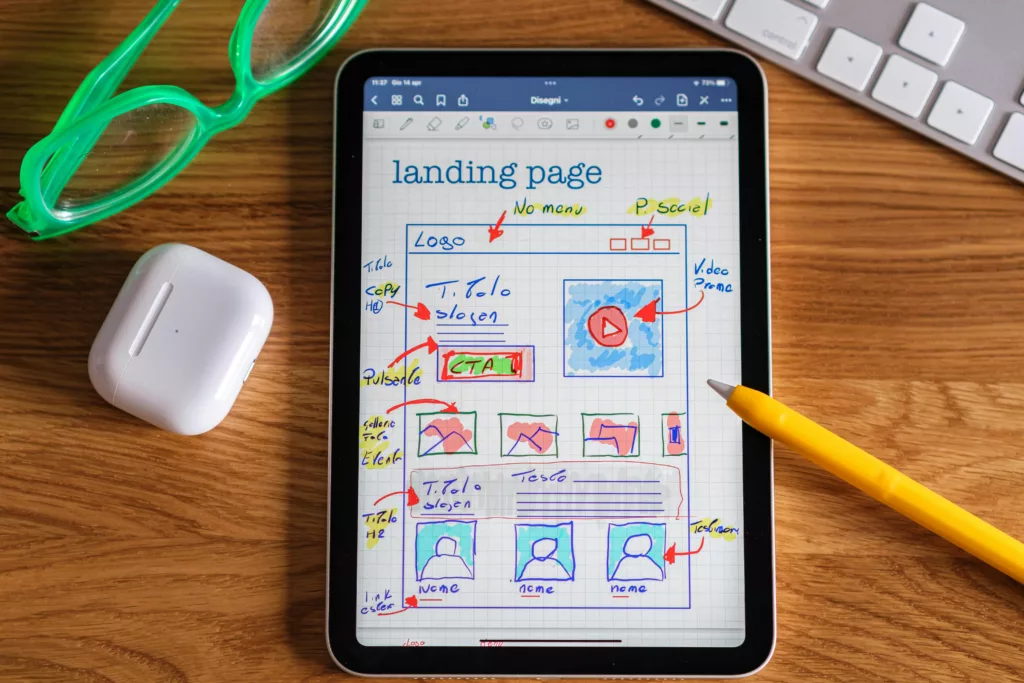In today’s digital landscape, a captivating website isn’t just a luxury, it’s a necessity. But for solution scouts juggling budgets and deadlines, the prospect of website development can feel like navigating a treacherous digital ocean. Fear not, cost-conscious comrades! We’ve assembled a treasure map of strategies to help you build a stunning website without breaking the bank. Through clever prioritisation, open-source savvy, and strategic partnerships, you’ll discover that a budget-friendly online presence is not just within reach, it’s within your grasp. So, hoist your sails, grab your digital compass, and get ready to embark on a cost-effective website development adventure!
Table of Contents
1. Leverage Content Management Systems (CMS):
Think of a CMS as your website’s Swiss Army Knife. It empowers you, the non-coding crusader, to build, manage, and update your web presence without needing to speak fluent programmers. These platforms provide pre-built structures, customisable templates, and drag-and-drop interfaces, making website creation accessible to anyone with a mouse and a modicum of creative spirit.
The best part? This user-friendliness translates to substantial cost savings. Forget shelling out big bucks for custom website development from scratch. With a CMS, you can ditch the dependence on web development services and take control of your website’s evolution, one click at a time.
But wait, there’s more! Here’s how different CMS options cater to specific website needs, further trimming your budget woes:
- Blogs: Open-source powerhouses like WordPress, Blogger, and Ghost reign supreme in the blogosphere. These platforms are free, flexible, and teeming with plugins to personalize your blogging experience.
- Landing Pages: If laser-focused conversions are your game, static site generators like Gatsby and Hugo are your allies. They create lightning-fast landing pages that are lean, mean, and SEO-friendly, without the bloat of traditional CMS software.
- Forums: For vibrant online communities, forum-specific software like MyBB or vBulletin are the go-to tools. They offer robust discussion tools and user management features, keeping your forum humming with activity.
- E-commerce Websites: Fear not, online merchants! Platforms like Shopify and WooCommerce have built-in CMS functionality, allowing you to effortlessly manage your product catalogue, orders, and customer interactions, all within a single interface.

And for those seeking a touch more flexibility, some platforms like WordPress offer “headless” CMS options. This separates the content management (back-end) from the presentation (front-end), giving you ultimate control over your website’s design and functionality.
Remember, choosing the right CMS is key to maximizing cost savings. Consider your website’s purpose, technical skillset, and budget to find the perfect platform that empowers you and your wallet.
By embracing the power of CMS, you’re not just building a website, you’re building a cost-effective, dynamic online presence that can grow and evolve alongside your business. So, unleash your inner website warrior, grab your chosen CMS, and get ready to conquer the digital landscape, one budget-friendly click at a time!
2. Prioritise Core Functionality and Minimize Feature Creep:
Let’s be honest: dreaming up a website bursting with every imaginable feature is exhilarating. But hold on, budget-savvy friends – feature creep, that sneaky villain, can lurk around the corner, inflating development time and costs like a runaway soufflé. Fear not, though! By laser-focusing on core functionalities that directly support your business goals and user needs, you can keep feature creep at bay and ensure your website delivers a stellar return on investment (ROI).
Think of it like building a lean, mean, conversion machine. Before adding fancy bells and whistles (think gourmet kitchen in a studio apartment), you need a rock-solid foundation:
- Crystal-clear navigation and user-friendly interface: Make finding information a breeze, keeping visitors engaged and clicking towards that sweet “convert” button.
- Responsive design: Adapt to all screens, from desktops to smartphones, ensuring a seamless experience across the digital landscape.
- SEO optimisation: Become a search engine darling, attracting organic traffic and boosting brand visibility like a social media superstar.
- Content management system (CMS) integration: Leverage the power of tools like WordPress or Shopify to manage your website content with ease, saving you from costly development fees.

Now, the million-dollar question: what gets the axe? Ask yourself:
- Does it directly contribute to our business goals? If it doesn’t drive conversions, sales, or brand awareness, it can wait.
- Is it essential for user experience? Features that add complexity or confusion might not be worth the development price tag.
- Can it be implemented later? Some features can be delightful add-ons for future phases when your budget allows.
By strategically prioritising and ruthlessly trimming unnecessary features, you’ll build a cost-effective website that packs a punch. Remember, you can always add bells and whistles later, but a strong foundation of core functionalities is like the secret sauce to online success.
This focus on essentials also beautifully complements our previous point on CMS. With its user-friendly interface and content management magic, a well-chosen CMS simplifies updates and eliminates the need for costly feature additions through development services. It’s a budget-conscious match made in website heaven!
So, channel your inner prioritization ninja, slice and dice feature creep with precision, and build a website that delivers optimal ROI without breaking the bank. Sometimes, less truly is more, especially when it comes to crafting a cost-effective and impactful online presence.
3. Embrace Open-Source Resources and Templates:
Remember the thrill of finding hidden gems? That same excitement awaits in the world of open-source resources and templates for your website. Think of it as a treasure trove overflowing with free, high-quality building blocks ready to elevate your online presence without denting your budget.
But before you grab the nearest shovel and start digging, let’s set the map straight. Open-source isn’t just about getting something for nothing; it’s about community, collaboration, and empowerment. These resources are crafted by talented folks who believe in sharing their expertise, giving you access to a vast network of pre-built themes, plugins, and tools, all waiting to be unleashed on your website.

So, where do you start your treasure hunt? Here are some trusty gold mines:
- Theme libraries: WordPress.org boasts a stunning collection of free themes for all sorts of websites, from sleek portfolios to vibrant e-commerce platforms. No coding required, just choose, click, and customize!
- Plugin paradise: From SEO optimization to contact forms, the WordPress plugin repository is your one-stop shop for adding functionality without hefty development costs. Imagine adding social media integrations, lead capture forms, and analytics tools for free!
- Framework finesse: Frameworks like Bootstrap and Foundation provide pre-built styles and layouts, giving you a solid foundation to build upon, even if you’re not a design guru. Think of it as instant visual polish, minus the hefty price tag.
But before you get carried away, remember: quality matters. Not all open-source treasures are created equal. Choose reputable sources, check community reviews, and ensure the resources are regularly updated and compatible with your chosen platform.
Now, some might say, “free comes with downsides.” True, there might be less hand-holding compared to custom development, but that’s where the community spirit kicks in. Online forums, documentation, and tutorials abound, filled with fellow adventurers ready to lend a helping hand. Plus, the satisfaction of tinkering and customizing your website yourself is invaluable!
By strategically leveraging open-source resources, you’re not just saving money; you’re fostering creativity, learning new skills, and building a website that reflects your unique brand vision. It’s like planting a seed of web-savvy, watching it grow with your knowledge, and nurturing a budget-friendly online presence that blossoms without breaking the bank.
Remember, the first two sections emphasized prioritization and core functionalities. This section builds on that foundation, showcasing how open-source resources can enhance and personalize your website within your budget constraints. It’s like adding delicious spices to your website’s culinary masterpiece, enhancing its flavour without overwhelming your palate (or your wallet).
4. Consider Outsourcing to Skilled Freelancers or Agencies:
Ah, the outsourcing quandary – to delegate or to conquer, that is the question. Let’s face it, budget-savvy solution scouts, building a website can be a DIY haven or a collaboration waltz. So, should you hand the reins to skilled freelancers or agencies, or navigate the digital seas yourself?

Before we set sail, let’s hoist both the pros and cons of outsourcing:
Pros:
- Expertise on tap: Access a wider pool of specialized skills for complex functionalities, design, or development. Think of it like hiring a seasoned crew to tackle the technical storms.
- Time is money: Free up your schedule to focus on core business while the outsourced team tackles the website build. More time for strategic steering and less for fiddling with the rigging!
- Cost-effective flexibility: Depending on your needs, outsourcing can be more budget-friendly than hiring in-house personnel, especially for specific short-term projects. It’s like hiring a temporary deckhand without a long-term commitment.
Cons:
- Loss of control: Letting go of some control can be unnerving. Clear communication and defined milestones are crucial to ensure your website sails towards your vision, not theirs.
- Finding the right crew: Careful navigation is required! Vetting potential partners, checking portfolios, and establishing clear expectations are vital to avoid rogue waves of disappointment.
- Communication challenges: Time zones, cultural differences, and language barriers can cause misunderstandings. Invest in clear communication channels and regular check-ins to keep your web development ship on course.
Remember, outsourcing isn’t an all-or-nothing gamble. You can mix and match, leveraging in-house talent for core functionalities and outsourcing specific tasks like design or complex coding. It’s like having a versatile crew, some permanent, some hired per voyage, all working together to reach your digital destination.
Ultimately, the decision rests on your specific needs, budget, and comfort level. If you value time, expertise, and cost-effectiveness, and are willing to invest in clear communication and partner selection, outsourcing can be a smooth sailing breeze. But if you cherish complete control and enjoy the DIY journey, then charting your own course might be the most rewarding adventure.
Whatever your choice, remember the previous sections. Prioritizing core functionalities, utilizing free resources like open-source tools, and maintaining a clear vision will equip you to make informed decisions about outsourcing, ensuring your website development journey is an enriching and budget-conscious voyage.
5. Invest in Quality Assurance and User Testing:
Think of quality assurance (QA) as your meticulous first mate, constantly checking for broken links, wonky buttons, and glitches that could sink your user experience. It’s like preventative maintenance for your website, identifying and fixing issues before they surface, saving you the agony of frustrated visitors and potential lost conversions. Early QA is a budget-friendly investment, preventing the costly headache of fixing major problems later, like a cracked mast discovered halfway through your voyage.
And then there’s user testing, your insightful navigator. By observing real users interact with your website, you gain invaluable insights into how well it sails. Do they get lost in the map (navigation)? Do they struggle to find the treasure (key information)? User testing helps you identify and smooth out any rough patches, ensuring a seamless and intuitive journey for your visitors. It’s like having a trusted crew member chart the most efficient course, saving you time and resources by optimizing your website for maximum user engagement.
Remember the prioritisation from section two? QA and user testing help you double-check that you’re focusing on the features that matter most to users, ensuring your development efforts aren’t lost at sea. And think back to the open-source treasures from section three. User testing can help you refine your chosen themes and plugins, ensuring they’re truly user-friendly and enhance your website’s usability.
Whether you’ve sailed solo or with a hired crew, investing in QA and user testing is always a wise decision. It’s like taking your website out for a test drive before setting sail across the vast digital ocean. You’ll identify potential trouble spots early, saving yourself the cost of repairs and ensuring your online voyage is smooth, efficient, and ultimately, profitable.
Conclusion
Congratulations, solution scouts! You’ve conquered the five pillars of budget-friendly website development. By prioritising core functionalities, leveraging open-source resources, considering outsourcing options, and investing in quality assurance and user testing, you’ve equipped yourself to navigate the digital seas with confidence and cost-effectiveness. Remember, your website is a living, breathing entity, so don’t be afraid to experiment, test, and refine. Embrace the continuous optimisation journey, and you’ll find that your budget-savvy website blossoms into a powerful tool for engagement, conversion, and brand success. Now, go forth and conquer the digital world, one cost-effective click at a time! Vinova is here as your trustful partner to help you create an affordable but effective website
Check out our Website Development Service for more information!